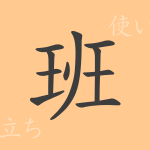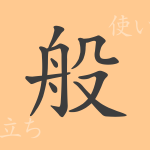In the intricate tapestry of Japanese character culture, each kanji carries unique meanings and histories. “畔” (ハン, あぜ, くろ) might not be frequently seen in everyday life, yet it holds a special place in conveying the depth of Japanese culture and language. This article explores the origins, meanings, applications, pronunciation, and related phrases of “畔”, inviting you on a journey to understand this common kanji used in Japan.
Origins of 畔 (ハン, あぜ, くろ)
The kanji “畔” traces back to ancient China, originally representing the edges of rice fields or riverbanks. It evolved from the characters for “spotted” or “mottled”, with “畔” being used to indicate dividing these areas, gradually coming to symbolize the boundaries themselves, intimately connected to people’s lives.
Meaning and Usage of 畔 (ハン, あぜ, くろ)
“畔” primarily denotes ‘the edges of fields’ or ‘banks of a river’. It is used specifically to refer to paths between paddies as in “田畔” (たあぜ) or the banks of a river as in “川畔” (かわぎわ). Metaphorically, it can also indicate differing positions or viewpoints.
Pronunciation, Stroke Count, and Radical of 畔 (ハン, あぜ, くろ)
The kanji “畔” has several readings and features:
- Pronunciation: The on-reading is “ハン”, and the kun-readings are “あぜ” and “くろ”.
- Stroke Count: “畔” consists of 10 strokes.
- Radical: The radical is “田” (た), related to the field kanji.
Phrases and Idioms Using 畔 (ハン, あぜ, くろ) and Their Meanings
There are several idioms and phrases that include “畔”, each enriching the Japanese language:
- 田畔 (たあぜ): Refers to the pathways or embankments between rice paddies.
- 川畔 (かわぎわ): Means the riverside or riverbank.
- 畔上 (あぜうえ): Literally the top of a ridge between fields, metaphorically implying a superior position.
- 畔道 (あぜみち): A path running along the ridge between fields.
Summary on 畔 (ハン, あぜ, くろ)
The kanji “畔” is rooted in the natural and geographical aspects of Japan, closely tied to the traditional Japanese lifestyle. While it concretely refers to locations like field edges and riverbanks, it also symbolically represents boundaries and differing stances. Engaging with kanji like “畔” offers insights into the cultural and historical contexts underlying the Japanese language, enhancing the appreciation of its depth as one learns more about these characters.

























